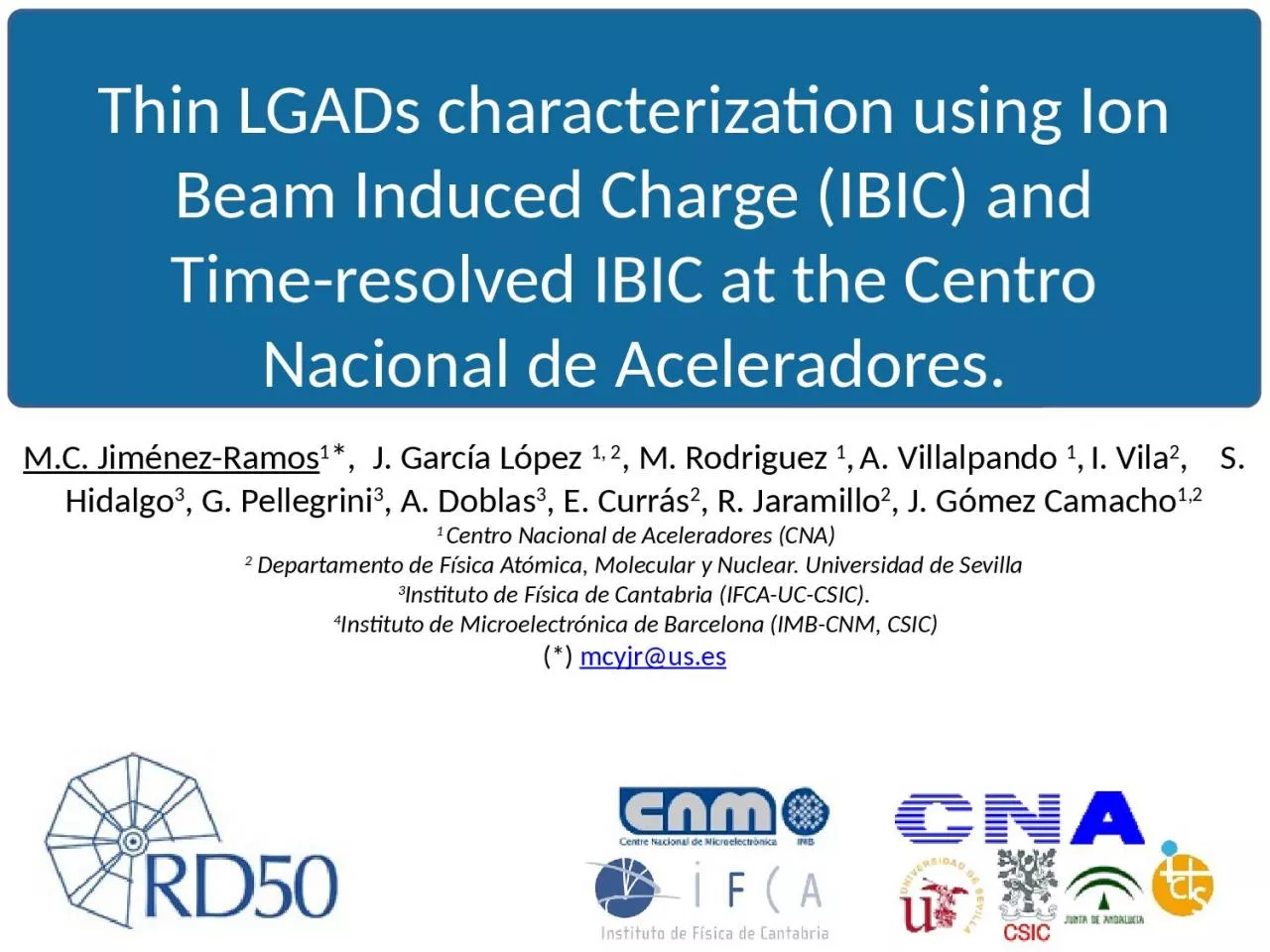/


J García López 1 2 M Rodriguez 1 A Villalpando 1 I Vila 2 S Hidalgo 3 G Pellegrini 3 A Doblas 3 E Currás 2 R Jaramillo 2 ID: 1042748
Download Presentation The PPT/PDF document "M.C. Jiménez-Ramos 1 *," is the property of its rightful owner. Permission is granted to download and print the materials on this web site for personal, non-commercial use only, and to display it on your personal computer provided you do not modify the materials and that you retain all copyright notices contained in the materials. By downloading content from our website, you accept the terms of this agreement.
1. M.C. Jiménez-Ramos1*, J. García López 1, 2, M. Rodriguez 1, A. Villalpando 1, I. Vila2, S. Hidalgo3, G. Pellegrini3, A. Doblas3, E. Currás2, R. Jaramillo2, J. Gómez Camacho1,2 1 Centro Nacional de Aceleradores (CNA)2 Departamento de Física Atómica, Molecular y Nuclear. Universidad de Sevilla3Instituto de Física de Cantabria (IFCA-UC-CSIC). 4Instituto de Microelectrónica de Barcelona (IMB-CNM, CSIC)(*) mcyjr@us.esThin LGADs characterization using Ion Beam Induced Charge (IBIC) and Time-resolved IBIC at the Centro Nacional de Aceleradores.
2. 33th RD50 WorkshopWhat is Ion Beam Induced Charge? MeV ion beamV0ElectrodesCharge sensitivepreamplifierVoutAmplifierADC +MCASame electronic chain as used in nuclear spectroscopyEinitialhe-1- Deposited Energy2- Carriers generation3- Transport4- Output signalVout=f (E deposited &free carrier transport)2
3. Nuclear microprobe ~ 2 mm spot sampleBEAMX, Y scanning systemMagnetic Q-poles Ion beam current: nA to few pps (micrometric slits) Scanning system: few mm2 Synchronous signal acquisition system with scanning: mappings What is Ion Beam Induced Charge?33th RD50 Workshop3
4. What is Ion Beam Induced Charge?Sum spectrum from the whole scanChannel ~ Q generated ~ E measured33th RD50 Workshop4
5. What is Ion Beam Induced Charge?0123456789101133th RD50 WorkshopScan areaABCDEABCDEIrradiated zonePristine zone5
6. RD50 Proposal33th RD50 Workshop6
7. Four sectors 50 µm LGAD fabricated by IMB-CNM33th RD50 WorkshopLateral charge collection homogeneityPeripheral StructuresGain curveTRIBIC7
8. Four sectors 50 µm LGAD assembly by IFCA33th RD50 Workshop- Bonding and electrical characterization by IFCA/CERN- Dedicated PCB for laser and IBIC measuremts8
9. Charge generated across the detector33th RD50 Workshop9Total charge in 50 µm:3 MeV protons → 50fCMIP → 0,6 fC
10. Charge Collection homogeneityLGAD W4-B231 #3: 3 MeV protons & +90V; 2.5*2.5 mm2Lateral charge collection is not homogeneous (<10%)Peripheral Structures are observedA defect is seen (red circle)The wire bonding is well resolvedEFGHI10The color intensity is related to the number of counts in each position and the maps are related to the different energy windows
11. Peripheral Structures Channel 1Channel 2 1960 µmSignals from channel 1 & 2 80 µmV1= V2 = +90V 20 µm 20 µm33th RD50 Workshop11
12. Peripheral Structures: LGAD vs PIN 33th RD50 WorkshopEnd of multiplication layer of each sectorP-stop common for the two sectorsPINSingle structure with 1/2 CCE shared by the two sectorsLGADOne structure for each sector with a CCE value lower than 50%. Analysis along the vertical direction1290 µm
13. 30th RD50 Workshop 5-7 June 2017 KrakówLGAD W4-B231 #3 vs W4-B232P #3 13
14. Gain Curve Gain vs Voltage for different positions within the sensor3 MeV protons33th RD50 Workshop14G(40V) > G(45V) > G(50V)!!!
15. LGAD W4-B231: Gain calculations 15Multiplication Factor a b Ionization coefficientselectrons holes80 V40 VGain (80V)/ Gain (40 V)=Calculation: 1.09IBIC: 1.07Absolute Gain (@40V)=Calculation: 4.4IBIC: 5.7Y. Musienko et al., NIMA, 2000.
16. TRIBIC (preliminary measurements) MeV ion beamElectrodesGeneration of e-h pairsIonization profile dE/dx (SRIM)Einitialhe-Fast oscilloscopeTransient signal(TRIBIC)Without amplification stage between detector and scopeSelf-trigger: working in DAQ improvementsExternal trigger system ongoing33th RD50 Workshop16
17. New sample holder for IBIC at -20ºC17
18. Thank you for your attention
19. LGAD W4-B231: Gain Curve 19G (LGAD)/G (PIN) = 5.8 for 3 MeV protons (@40V) G (LGAD)/G (PIN)= 3.2 for 5.5 MeV protons (@40V)
20. Generated charge profile33th RD50 Workshop20
21. 21
22. 22